Mladen and Del review ‘Valerian and the City of a Thousand Planets’

Image courtesy of STX Entertainment.
“Valerian and the City of a Thousand Planets” Staring Dane Dehaan, Cara Delevinge, Clive Owen, Rihanna, Rutger Hauer and Ethan Hawke. Directed by Luc Besson. 137 minutes. Rated PG-13.
Mladen’s take
It’s tough to criticize a mediocre movie such as “Valerian,” which I saw opening weekend. The film had some terrific scenes and a dose of charm. Unfortunately, all of them came in the first 30 to 40 minutes.
There was the pithy beginning which spanned some 400 years of space-time. It cleverly explained how we got to the period covered in the vividly constructed movie by “Fifth Element” director Luc Besson. There was even something pleasant about the peaceful extraterrestrial world that we see destroyed by massive disabled interstellar fighting ships falling from the sky during a battle. That world, the world of the Mul, reminded me of the hermit crab terrariums tourists find in the campy souvenir stores in my Northwest Florida hometown. Mul land was all oversized shells, lots of sand, and calm blue water.
My favorite part of the film depicted our heroes, Valerian and Laureline, recovering a “converter” amid a trans dimensional brawl. Particularly clever was the way Besson depicted Valerian trying to fight and survive while different parts of his body were stuck in two separate realities.
Then, the movie falters. It’s not that any one scene was bad. They just lacked spunk. Plus, the youngsters playing the heroes lacked the street creds that were needed to make their cause inspiring.
I’m irritated that the movie’s marketing listed Rutger Hauer and John Goodman as stars. Hauer, perhaps best known for his role as the soldier clone with a tortured soul in “Blade Runner,” appeared for, maybe, 2 minutes. Goodman provided the voice for a Jabba the Hut-sequel pawnshop owner and mobster. That lasted, maybe, 3 or 4 minutes. Clive Owen, who was superb in the lead role in “Children of Men,” a magnificent sci-fi film that, for some reason, has gone largely unrecognized by moviedom, missed the mark as a fiendish military commander trying to hide a severe misdeed. Ethan Hawke also played a supporting role, but it was unimpressive.
And, there was some crappy editing. The scene with a famous singer/dancer portraying a shapeshifting illegal alien was completely unnecessary. The sequence should’ve been cut, saving the audience about 7 or 8 minutes of frustration. Finally, ‘Valerian’s’ PG-13 rating was a disservice. Well-placed strategic cussing and blood and gut splatter would have given the film a more mature feeling.
Valerian will not become a cult favorite as happened with Besson’s ‘Fifth Element.’ Is the film worth seeing in the theater? Maybe. It’s your dime.

Del’s take
I’m no expert on science fiction. I read it, write it and watch it. When I do I am mostly having fun, not looking for ways to enlarge my brain.
But even so woeful a student as I have noticed a fundamental difference in the way European directors approach SF opposed to their American counterparts (and I might extend that difference to writers, too).
American science fiction strikes me as techno-centric, while in Europe it’s all about style. “Valerian” is a good example.
Besson is a talented director who imbues his films with color, beauty and wit. His characters are usually interesting, including their flaws (they don’t get much more flawed than Jean Reno in “Leon: The Professional”).
His last outing into things outer space was the stylish and funny “The Fifth Element,” which has become a science fiction fan favorite, if not a cult film.
“Valerian” is also stylish and sometimes funny. But it lacks the snappy screenplay and perfect casting of “The Fifth Element,” resulting in a kind of chubby “Fifth Element” lite that bores as much as it entertains.
Valerian (Dehaan) and Sgt. Laureline (Delevinge) are 28th century cop partners who are driven to investigate a mysterious radioactive dead spot growing within Alpha, a spaceborne city that has accreted over the centuries to become a galactic meeting center for spacefaring races. The two are thrown into an Indiana Jones-style quest to solve the mystery and correct a terrible wrong. Simultaneously, Valerian is smitten by Sgt. Laureline and determined to win her hand in marriage, despite his reputation as a womanizer.
The movie is a feast for the eyes, blazing with vibrant colors and new ideas about aliens and their environments. While other science fiction properties are content with forehead ridges or glued-on ear extensions (ahem, “Star Trek,” this might be you I’m knocking), “Valerian” gives us weirdly unique critters the likes of which I haven’t seen since “Babylon 5.”
But the story is pretty much standard fare, the-universe-hangs-in-the-balance popcorn that does not explore any new ideas or challenge your ideas about the universe like the really good science fiction films, for example “2001” or “Arrival.” In fairness, it’s not supposed to.
The movie is overweight with unnecessary scenes. Mladen pointed out one offender, a performance by Rihanna that could easily have been cut. Seems Besson must have at least one song and dance number in each of his movies, which is a shame. If he had slain his little darlings, “Valerian” would have moved ahead at warp speed instead of plodding on impulse power.
My big gripe was in the casting. Don’t get me wrong – I’m a huge fan of Dane Dehaan. If you haven’t seen “Chronicle” you’re missing a science fiction treat. But Dehaan is wasted in the Valerian role, which plays to none of his strengths. As a love interest for Delevinge he fails completely, coming across as a moonstruck adolescent pining to get laid, sadly unlike his tough but likeable and romantic predecessor, Korben Dallas of “The Fifth Element.”
I was forewarned Delevinge was a bad actor, but she seemed fine in her role, at times outshining Dehaan and others sharing the screen. Mladen is right. Rutger Hauer’s role can be measured in seconds and Ethan Hawke is on the screen and gone before you can ask “Is it over yet?”
“Valerian” isn’t a bad movie. I credit Besson for giving us an alternative to the caped dreck pouring out of Hollywood’s hind-end like a bad bout of Montezuma’s Revenge (I can see it now … “MONTEZUMA’S REVENGE … the dark tide rises!). I wish it had been shorter, smarter, and better cast, but I guess you can’t have it all.
Absolutely see it at the theater. It’s stunning visuals will be lost on the small screen, unless you’ve got a curved wall-o’-TV parked in your living room.
Oh, and do watch “Chronicle.”
I give “Valerian” a B for originality and visual presence.
Mladen Rudman is a former journalist and technical editor. Del Stone Jr. is a former journalist and author.

Image courtesy of Warner Brothers.
“Dunkirk” Starring Fionn Whitehead, Damien Bonnard, Harry Styles, Mark Rylance, Tom Hardy, and Tom Glynn-Carney. Directed by Christopher Nolan. 106 minutes. Rated PG-13.
Del’s take
Christopher Nolan does not make movies. He builds monuments, towering edifices that reach for the heavens as intricate conspiracies of space and time that dwarf the efforts of mere mortal filmmakers. “Dunkirk” is no exception. Like its predecessors, “Interstellar,” “Inception” and even “Memento,” “Dunkirk” fits together with an old-school clockmaker’s eye for precision and a craftsman’s appreciation for complexity and detail.
It is an excellent movie, perhaps worthy of the Oscar talk surrounding it, and I wouldn’t mind seeing Nolan rewarded with a statuette. But for my purposes “Dunkirk” lacks a single ingredient, missing from all Nolan movies, that would make it the best film of the year.
The story is told from three different temporal viewpoints – a week, a day, and an hour – by multiple viewpoint characters. Foremost is an unnamed British soldier (“Tommy” in the credits) (Whitehead) who is desperate to escape advancing Germans and not above a peccadillo or two to get aboard a boat heading west. Others include Mr. Dawson (Rylance), who captains one of the small boats credited with saving hundreds of thousands of British and French soldiers from the beaches of Dunkirk. Tom Hardy’s role happens over a single hour as he pilots a Spitfire in battles with Messerschmitts, Heinkels and Junkers.

For those not up on their history, in the early days of World War II Hitler’s Germany, after finishing its conquest of Poland, invaded western Europe using a new fighting technique called “blitzkrieg,” or “lightning war,” where tanks and mechanized artillery, augmented by ground attack aircraft, moved at rapid pace to confuse and destroy opposing forces. In a few short days the Germans were able to surround the British and French armies that had deployed to northern France and Belgium, and threaten them with obliteration. Those armies had retreated to Dunkirk, where their commanders hoped the Royal Navy would carry them back to England. But the navy suffered grievous losses to marauding Luftwaffe bombers and U-boats and pulled their forces back. It was not until an armada of privately owned craft crossed the Channel did the soldiers find a way home – over 300,000 of them by the time it was over.
It may sound confusing, but the storytelling works itself out about mid-movie when you realize the three narratives are beginning to overlap and will presumably converge toward movie’s end. I’m not sure such a gimmick was necessary, but it does allow Nolan to focus on characters and not events, a characteristic of many war movies.
Acting was solid through and through. Newcomer Whitehead did a credible job, as did Styles in his role as a British soldier. Rylance proved again why he is an Academy Award winner, and his teenaged son, Glynn-Carney, rose above more experienced actors, such as Cillian Murphy.
The script was well written with only a few expository lapses here and there – Nolan loves to “explain” things or conduct info-dumps through dialogue. The score worked for me and visuals were mostly satisfying, although at times I could tell the difference between models or CGI and the real thing.
A few gripes: One subplot, where soldiers board a beached boat and wait for the tide to come in, goes on and on to the point of absurdity. And a historical error – Nolan has his Spitfires and Messerschmitts tangling at low altitude, only a few hundred feet above the waves. During the Dunkirk evacuation the air battles occurred at a much higher altitude, prompting British foot soldiers to ask, “Where was the RAF?”
My large complaint was with the strange lack of human warmth evoked by “Dunkirk.” Nolan, I fear, is more technician than artist, and as meticulous and grand as his movies may be, they don’t inform to the heart. The characters and their actions are merely a clockspring or spoked wheel in the Nolan gadget that tells a great story, but tells it mechanically. Call it the Uncanny Effect – it looks like human but is missing just enough to provoke a feeling of unease.
Still, “Dunkirk” is an excellent movie and you should buy a ticket and watch it in the movie theater, because that is where movies should be seen. Don’t be surprised if Nolan received an Oscar nomination for best director, nor should you be surprised if he wins. He is probably overdue.
If only Geppetto’s creation would discover that it is a real boy.
Del Stone Jr. is a former journalist and author.

[ Primary image courtesy of Free SVG ]
From Amazon:
Adventures in the Arcane is back! And we’ve expanded to eight thrilling stories. The characters you love from Volume I return, including Captain Argo, Dominic Ashwood, Waylon and Jester, Dempsey and Drood.
Our guest authors, including pulp legend Ron Goulart, bring you four terrific tales guaranteed to set your heart racing. Inside you’ll find femme fatales, vengeful ghosts, mysterious islands, and deadly dream worlds.
Lock your door, brew some coffee, and light a candle. Then open this book and prepare to be thrilled!
A Syndicate Production featuring the work of Mark Boss, S. Brady Calhoun, Ruth Corley, Mark Douglas Jr., Ron Goulart, Jayson Kretzer, Tony Simmons, and Del Stone Jr.
If you would like to order a copy of “Adventures in the Arcane, Volume II,” following this link.
About the author:
Del Stone Jr. is a professional fiction writer. He is known primarily for his work in the contemporary dark fiction field, but has also published science fiction and contemporary fantasy. Stone’s stories, poetry and scripts have appeared in publications such as Amazing Stories, Eldritch Tales, and Bantam-Spectra’s Full Spectrum. His short fiction has been published in The Year’s Best Horror Stories XXII; Alfred Hitchcock’s Mystery Magazine; the Pocket Books anthology More Phobias; the Barnes & Noble anthologies 100 Wicked Little Witch Stories, Horrors! 365 Scary Stories, and 100 Astounding Little Alien Stories; the HWA anthology Psychos; and other short fiction venues, like Blood Muse, Live Without a Net, Zombiesque and Sex Macabre. Stone’s comic book debut was in the Clive Barker series of books, Hellraiser, published by Marvel/Epic and reprinted in The Best of Hellraiser anthology. He has also published stories in Penthouse Comix, and worked with artist Dave Dorman on many projects, including the illustrated novella “Roadkill,” a short story for the Andrew Vachss anthology Underground from Dark Horse, an ashcan titled “December” for Hero Illustrated, and several of Dorman’s Wasted Lands novellas and comics, such as Rail from Image and “The Uninvited.” Stone’s novel, Dead Heat, won the 1996 International Horror Guild’s award for best first novel and was a runner-up for the Bram Stoker Award. Stone has also been a finalist for the IHG award for short fiction, the British Fantasy Award for best novella, and a semifinalist for the Nebula and Writers of the Future awards. His stories have appeared in anthologies that have won the Bram Stoker Award and the World Fantasy Award. Two of his works were optioned for film, the novella “Black Tide” and short story “Crisis Line.”
Stone recently retired after a 41-year career in journalism. He won numerous awards for his work, and in 1986 was named Florida’s best columnist in his circulation division by the Florida Society of Newspaper Editors. In 2001 he received an honorable mention from the National Lesbian and Gay Journalists Association for his essay “When Freedom of Speech Ends” and in 2003 he was voted Best of the Best in the category of columnists by Emerald Coast Magazine. He participated in book signings and awareness campaigns, and was a guest on local television and radio programs.
As an addendum, Stone is single, kills tomatoes and morning glories with ruthless efficiency, once tied the stem of a cocktail cherry in a knot with his tongue, and carries a permanent scar on his chest after having been shot with a paintball gun. He’s in his 60s as of this writing but doesn’t look a day over 94.
Contact Del at [email protected]. He is also on Facebook, twitter, Pinterest, tumblr, TikTok, Ello and Instagram. Visit his website at delstonejr.com .
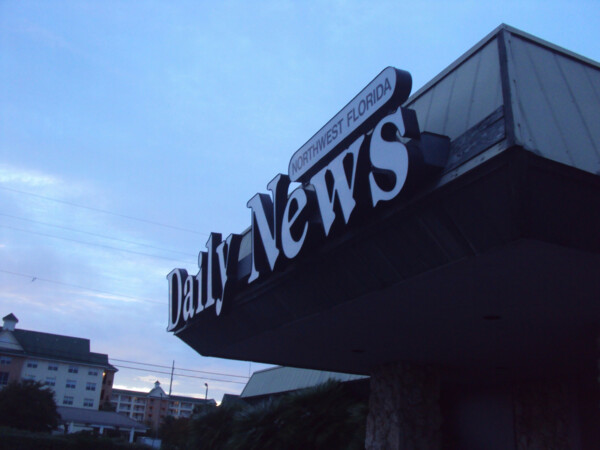
Image courtesy of Del Stone Jr.
Today marks my 38th anniversary of working at the Daily News.
I have bored you in the past with stories about life at the newspaper in the “olden” days, so I won’t repeat that sin.
Oh, maybe I will. A little.
I remain astounded by the changes that have taken place in the newspaper industry (and society in general) since 1979. We are living in an age of science fiction where the world arrives at our doorstep – live – 24 hours a day.
In 1979 we had primitive wire feeds on primitive monochromatic computer terminals that connected to a twitchy mainframe in a cold room. Today the storage in our phones exceeds the storage of that mainframe by many factors of bytes.
I started at the Daily News when “cut and paste” literally meant cutting and pasting, and I know I’ve related that anecdote before but you’ll have to suffer it again, because that’s what people my age do.
The world was different then, too. I think people were much more civic-minded and had a better understanding of the basic functionalities of their city, county, court and law enforcement systems than people of today, who seem more selfish and less educated than ever.
In 1979 the music world approached the precipice of a revolution which would save us from the ravages of disco, off-key raspy-voiced folk singers and worst, country music. New Wave and MTV. The music of the ‘80s was the best. THE best.
Fashions were as strange as they are every decade. At times I had a mullet, a rat tail, fingerless gloves, rolled-down socks, rolled-up blue jeans and collarless shirts.
I have witnessed and participated in all of the major recent journalism revolutions. The first I remember was the Design Revolution – in other words, newspapers actually started to give a damn about page design. Then there was the writing revolution, which disposed of the inverted triangle in favor of a conversational approach to storytelling. There was the graphics revolution ushered in by USA Today, the color revolution, the story length revolution ( an 8-inch story was an epic), and finally, and continuing, the ever-evolving digital revolution, which began with digital photos and continued with Photoshop, then pagination, the internet, and finally mobile technology.
I started as a page designer and beat reporter, then became the design editor and a columnist. I redesigned the Daily News in 1986 and I’m proud to say that basic design lasted until 2006. At times I was the city editor, weekend business section editor, Monday Focus editor, features editor, projects editor and whatever else they wanted to throw at me editor.
My crowning achievement as features editor was an insane Food page about hot dogs that had people calling the newspaper for weeks asking for copies. We had a lot of fun with that page.
Then in 2007 editor Pat Rice called me into his office and said, “You can put together those feature sections in your sleep. I want you to become our next online editor. You don’t have to know how to make the machine go BING. Just put stuff on the website.”
All because I designed a tropical weather Myspace page, complete with ethereal music playing in the background.
So I got into this website stuff. Our page was doing OK with about 2.5 million page views per month. Then it went up to 3 million. Then 4. Then 5. And 6. It topped out during Deepwater Horizon with an astonishing 8 million, but if you had added in the mobile views it would have been 10.
And that’s where things stand today. I continue to work on the website, and I love trying to figure out ways to get people to click. Not just click, but click in the tens of thousands.
I love trying to put together projects. Year before last I did a massive project on the monarch butterfly, which nobody read or gave a shit about. I interviewed the top experts in North America and wrote what I felt was a definitive summary of the monarch’s plight. I don’t know if it helped, but I do know I saw more monarchs last year.
Right now I’m the longest-employed person at the Daily News. Some people would see that as a failure – he couldn’t succeed anywhere else so he stayed here. I stayed, yes. Because I love Fort Walton Beach, enjoyed what I was doing, and had a rich off-camera life that satisfied me in many ways.
The future is uncertain but that is the nature of the news business. I have prepared for that uncertainty. At this point all I can do is hope for the best and try to do an exemplary job, even if I’m a crusty old geezer with barnacles on my belt.
The Daily News’ website is alternately No. 2 or No. 1 in the company’s retinue of websites, depending on the month. Not bad, for a tiny paper in the Florida Panhandle, in a company with over 300 newspapers to its name. I am only partly responsible for that success, but at age 62 I’m glad to still be relevant and still be playing a role, whatever that role may be.
Newspaper reporters and editors once ended their stories with a “-30-” which had something to do with the old telegraph system, from what I understand. I learned that while researching reporter Jeff Newell’s obit. I wrote an editorial about Jeff, saying farewell to a respected and honorable journalist who passed after a long battle with cancer.
So I will end this digital note with the hope that in two years I will be telling you about the cut and paste, the monochromatic computer screens, MTV, and all that old crap you don’t care about but still mean so much to me.
-30-
About the author:
Del Stone Jr. is a professional fiction writer. He is known primarily for his work in the contemporary dark fiction field, but has also published science fiction and contemporary fantasy. Stone’s stories, poetry and scripts have appeared in publications such as Amazing Stories, Eldritch Tales, and Bantam-Spectra’s Full Spectrum. His short fiction has been published in The Year’s Best Horror Stories XXII; Alfred Hitchcock’s Mystery Magazine; the Pocket Books anthology More Phobias; the Barnes & Noble anthologies 100 Wicked Little Witch Stories, Horrors! 365 Scary Stories, and 100 Astounding Little Alien Stories; the HWA anthology Psychos; and other short fiction venues, like Blood Muse, Live Without a Net, Zombiesque and Sex Macabre. Stone’s comic book debut was in the Clive Barker series of books, Hellraiser, published by Marvel/Epic and reprinted in The Best of Hellraiser anthology. He has also published stories in Penthouse Comix, and worked with artist Dave Dorman on many projects, including the illustrated novella “Roadkill,” a short story for the Andrew Vachss anthology Underground from Dark Horse, an ashcan titled “December” for Hero Illustrated, and several of Dorman’s Wasted Lands novellas and comics, such as Rail from Image and “The Uninvited.” Stone’s novel, Dead Heat, won the 1996 International Horror Guild’s award for best first novel and was a runner-up for the Bram Stoker Award. Stone has also been a finalist for the IHG award for short fiction, the British Fantasy Award for best novella, and a semifinalist for the Nebula and Writers of the Future awards. His stories have appeared in anthologies that have won the Bram Stoker Award and the World Fantasy Award. Two of his works were optioned for film, the novella “Black Tide” and short story “Crisis Line.”
Stone recently retired after a 41-year career in journalism. He won numerous awards for his work, and in 1986 was named Florida’s best columnist in his circulation division by the Florida Society of Newspaper Editors. In 2001 he received an honorable mention from the National Lesbian and Gay Journalists Association for his essay “When Freedom of Speech Ends” and in 2003 he was voted Best of the Best in the category of columnists by Emerald Coast Magazine. He participated in book signings and awareness campaigns, and was a guest on local television and radio programs.
As an addendum, Stone is single, kills tomatoes and morning glories with ruthless efficiency, once tied the stem of a cocktail cherry in a knot with his tongue, and carries a permanent scar on his chest after having been shot with a paintball gun. He’s in his 60s as of this writing but doesn’t look a day over 94.
Contact Del at [email protected]. He is also on Facebook, twitter, Pinterest, tumblr, TikTok, Ello and Instagram. Visit his website at delstonejr.com .

Image courtesy of 20th Century Fox.
“Alien: Covenant” Starring Michael Fassbender, Katherine Waterston, Billy Crudup, Danny McBridge, Demian Bichir. Directed by Ridley Scott. 122 minutes. Rated R.
Del’s take
“Alien: Covenant” is probably the movie you wish “Prometheus” had been.
It has a lot going for it: Storytelling is slick and efficient, eschewing junked-up plots and mystical mumbo-jumbo. Characterization is improved, with believable people speaking believable lines. And it does a creditable job of untangling the execrable birds’ nest of plotlines and unanswered questions presented by the afore-mentioned predecessor.
Director Ridley Scott sticks with the familiar and tries to evoke the grime and claustrophobia of “Alien,” while at the same time throwing in the rough-hewn desperation of “Aliens.” That’s where “Covenant” goes awry. In parts it is not so much an homage to the first two and best entries in the “Alien” canon but a blatant ripoff worthy of a J.J. Abrams flick.
Still, it’s not a bad movie and it puts the “Alien” franchise back on course with the possibility of future interesting sequels. For those all these reasons you should see it.
The movie stars Michael Fassbender as David or, schizophrenically, Walter, the yin and the yang of the story’s synthetic characters. Walter is a newer, more hepped up version of David who, unfortunately or fortunately, depending on your point of view, has been stripped of his ability to “create.” That ability also prevents him from slaughtering human beings; feel free to decide if that’s a good or bad thing. I personally feel it’s bad, but hey – no judgments here.
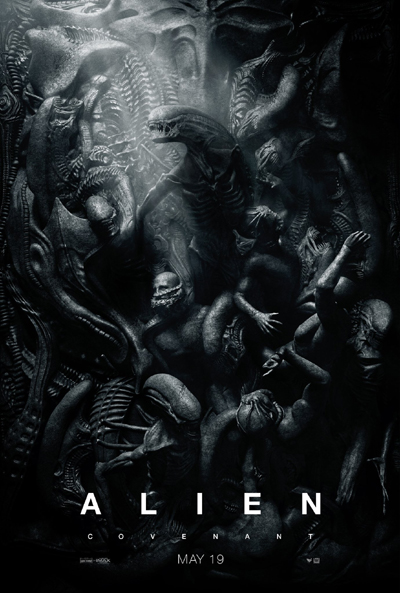
Walter is on board a colony ship headed for a distant planet when suddenly a neutrino storm strikes and the ship is disabled. The crewmembers are awakened from their hibernation pods to deal with the crisis and discover a closer planet more conducive to life. They are made aware of its existence by an incoming signal.
Hmmm. Where have we seen THAT before?
Upon awakening Katherine Waterston, who plays Daniels, almost immediately becomes the victim of a tragedy, one that ultimately brings the entire ship, crew and passengers into the jaws of peril. The tragedy potential is compounded when the decision is made to check out this signal, and this great new party spot on this interstellar pub crawl.
They land on a stormy planet to find a shattered city and the mummified corpses of thousands of its residents, the tall beings from “Prometheus.” Oh, and there’s another weird wreck of a U-shaped spaceship and finally David, who has lived here over the 10 years since the Prometheus disappeared.
They say idle hands are the devil’s playthings, and David has been very, very idle, or should we say very, very busy. Busy with what I won’t say, because that represents an answer to a critical question and it sets up the premise of the sequel. Suffice it to say Walter’s creators had good reason to leave out his creativity chip.
Apart from an opening soliloquy which could have been omitted without any loss to the film, “Covenant” moves along at a brisk pace, alternating between explanation and action. It does not feel like a two-hour movie. Scott, when he isn’t hobbled by a crappy screenplay, can still direct a lean and mean fighting machine of a film.
Fassbender is again superb as David and Walter, slipping back and forth between a polished Oxford and Midwest twang of accents with ease. Waterston is a kind of Signourney Weaver lite trying to fill the Ripley bandolier, but she doesn’t quite carry it off. Billy Crudup makes for a good sniveling Oram, the indecisive, overly religious mission commander who wants the crew to both love and respect him and succeeds at neither, The others are functionally cannon fodder who do rise above their meager contributions, so overall the acting component is effective.
The problem with “Covenant” is that it harkens back too often and too distinctly to “Alien” and “Aliens.” Let me count some of the ways:
1. The crew is summoned to an alien moon by a signal of unknown origin – check.
2. Crawling through dark passageways lit by strobes and punctuated by screaming alarms – check.
3. A rough ride to the surface in a drop ship led by a cowardly commander – check.
4. A tough female lead telling her fellow survivors, “We will seal off the accessways hatch by hatch and blow this motherfucker into outer space” – check.
5. The same tough female lead doing battle with the monster using a large piece of equipment – check.
Even the soundtrack borrows heavily from “Alien,” “Aliens” and “Prometheus.”
There were moments when I thought I was watching Ripley do battle with her extraterrestrial antagonist – THAT’s how similar the tone, pacing and more subtle ingredients, like color palette, were to those earlier movies.
That’s a problem for “Covenant” because those elements don’t mix well. “Alien” and “Aliens,” while sharing a similar premise, are two dramatically different movies, each with its own formulary for pacing and tension. You can’t blend the two and come away with a terrific cinematic experience no more than you can blend a pizza with a cheesecake and come away with a terrific gastronomic experience.
“Covenant” achieves a kind of limited success by answering questions and propelling the series into the realm of sequels, but its reliance on what has come before renders it into a derivative mashup that handicaps its ranking in the “Alien” pantheon. Of all the movies I would rate “Alien” the best with “Aliens” running a very close second. “Alien 3” was essentially a music video that nonetheless had an interesting look and feel, although it squandered all the grandeur of its predecessors. The Winona Ryder “Alien” was insipid and banal, and “Prometheus” was an unmitigated disaster.
Therefore I would place “Covenant” at a distant third on the list, and give it a generous grade of B.
Del Stone Jr. is a former journalist and author.

Image courtesy of Universal Pictures.
“The Fate of the Furious” Starring Vin Diesel, Dwayne Johnson, Michelle Rodriguez, Jason Statham, Ludacris, Tyrese Gibson, Charlize Theron, Kurt Russell, Scott Eastwood. Directed by F. Gary Gray. 136 minutes. Rated PG-13.
Del’s take
“The Fate of the Furious” is like that big dumb dog you loved as a kid. It didn’t have the sense to come in out of the rain, and chased its tail until it got sick and threw up. But it was loyal to a fault and would have protected you from the end of the world.
After watching this spectacle unfold before our eyes, Dusty commented that he could not believe a simple movie about street racing had grown into a monster franchise where globe-trotting villains threatened to bring about that very event your childhood mongrel would have protected you from.
Yet that’s what it has become, however improbable, and like that dog we loved, we remain faithful to the franchise. Worldwide “Fate” has already raked in almost $1 billion, more than earning back its $250 million production cost.
Does that mean “Fate” is a good movie? I don’t know. What’s your definition of “good”? If you’re looking for depth, metaphor and nuance, you should probably stay out of American movie theaters.
But if silly escapist action movies are your bag, “Fate” isn’t bad. If you can turn off your brain and accept the plot holes big enough to drive a turbocharged Mack truck through, avert your eyes to the impossible physics, and appreciate the reality that the good guys never miss and they never die, “Fate” will reward you with two hours of solid movie entertainment.
Otherwise you’ll need to move to France.
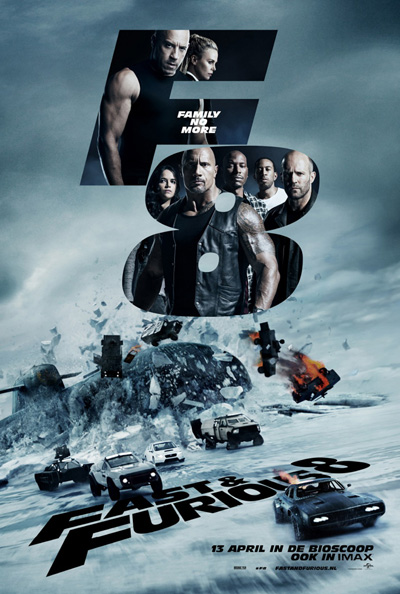
The story kicks off in Havana where Dom (Vin Diesel) and Letty (Michelle Rodriguez) are enjoying their honeymoon and making new street-racing friends when an unwelcome intruder, Cipher (Charlize Theron), shows him something on a phone that compels him to turn on his team during their next job, that of stealing an electronics-killing EMP device. The EMP theft is only the first of a series of jobs Cipher has in mind for Dom, all of them leading to the theft of … well, let’s just say if the theft is successfully carried out, the fate of the world hangs in the balance. Isn’t that always the case?
Dom’s team is called in to track down their now rogue ex-boss and thwart Cipher’s scheme, which takes them around the world driving any and all manner of sexy (and costly) vehicles, shooting big guns, and trading very funny quips.
The plot is less “The Fast and the Furious” and more “Thunderball,” which I suppose is what the series was doomed to become when each installment was required to surpass the previous. I wonder what’s next – hotrods in outer space?
The action was itself fast and furious, and the carnage epic. I for one cringed at the thought of Bentleys and Lamborghinis meeting the wrecking ball, but Dusty assured me the cars were being destroyed in CGI so I got over it.
All the old characters are along for the ride and they gamely soldier on. Newcomer Scott Eastwood did an OK job but did not quite pull off the comically bumbling understudy to Kurt Russell’s Mr. Nobody. Paul Walker’s absence did seem to leave a hole in the cast and perhaps affected the group dynamic, but other relationships rose in Walker’s absence, including a hilarious feud between Jason Statham’s Deckard and Dwayne Johnson’s Hobbs. Theron’s Cipher was not as cool, slick, and organically evil as, say, an Ernst Blofeld or Hans Gruber.
Overall the movie thunders toward its predictable conclusion amid a cloud of operatic destruction and comically over the top action, which is not a bad thing if you’re looking to kill 2 hours of a Saturday afternoon with a fuel-injected dose of turbocharged fun.
But “Fate,” like that dumb old dog, has not learned any new tricks, so don’t be disappointed if you come out of the theater feeling you’ve seen it all before.
I would grade this movie a B-.
Del Stone Jr. is a former journalist and author.

Image by Alex Wild, University of Texas at Austin, Creative Commons license.
With all the troubles facing the world, isn’t it nice that we can enjoy these weekly interludes discussing the issues that really matter, such as cockroaches crawling up the inside of your jeans leg.
Yes, that really happened. Our newest reporter, Heather Osbourne, who is eager to see her stories given away for free online because she has no bills or other financial obligations, told the story one day as I related a tale from a Facebook friend about a cockroach that turned up on her pillow. Which would you like to hear first?
Before she made the serious mistake of entering journalism, Heather worked as a physical therapist. One day as she was attending to a patient, she felt what she described as a tickling sensation on her leg, inside her jeans. The sensation became so persistent she went into another room to see what was causing it – and discovered a large cockroach crawling up her leg. Naturally, she screamed, which disturbed the patients and irritated the staff.
Scream?
Had it been I, the entire room would have been flamethrowered and salted with plutonium.
But that isn’t as horrible as the poor woman on Facebook who woke up and sensed that something was crawling on her pillow. When she turned on a light, she saw a large cockroach skitter away. She too screamed, as I would have, and put her husband to work killing the intruder as she stripped the bed of linens. I assume she washed them. I would have sent them on the next probe to Mars.
You’re sensing I don’t like cockroaches. Very perceptive.
My hatred started with an awful night spent trying to kill a six-legged unwelcome immigrant that invaded my bedroom and terrorized me for several hours. He was a frisky cuss that liked to fly — unnerving when he plopped on the hot metal lamp hood 6 inches above my face.
I sprayed Mr. Roach with insecticide and the thing went crazy, performing poison-induced acrobatics as it zinged around the room, sometimes on foot, sometimes in the air, at least once flying directly toward me. At one point I actually ran out of the room and slammed the door, gasping for breath, like every victim in every monster movie who is scheduled to die in the next frame.
At last the thing crawled into a box containing the pieces to a jigsaw puzzle (I think) and I slammed the lid shut, then listened to it scratch against the cardboard all night. I never opened that box again. I threw it in the garbage.
I think if one of the things touched me I might actually keel over dead – wait a minute! That actually happened (not the death part). I was opening the laundry room door when a cockroach dropped off the ceiling and fell down the back of my shirt. You talk about agile. I was doing the chicken dance all over the laundry room while screeching, “Ew, ew, ew!” and pawing at myself.
And, of course, there was the time Mom almost killed us. We were in our car, a ’68 Ford Torino, driving down Brooks Street when Mom felt something crawl across her gas pedal foot. She glanced down and saw a large bull cockroach on her foot. We nearly ran off the road while she tried to get the thing off her, and we did pull over to banish it from the car.
I was reminded of all this just yesterday. I walked into my bathroom, flicked on the light and instantly detected that something was amiss. It took a moment for my sleep-addled brain to register that a dark spot had appeared on the wall, and it was moving.
I keep a can of Raid in that bathroom because it seems to be the Ellis Island of cockroaches entering my house. For laughs you should see me reach for the air freshener and grab the can of bug spray instead.
I gave the roach a spritz of Raid – not air freshener – then ran for the door in the likely event the roach took to the air. It actually did fan its wings once or twice but ultimately fell into the bathtub with a wet, slapping sound, as if somebody had dumped a 48-pound cobia on the bathmat.
Living in Florida means coexisting with cockroaches and palmetto bugs, a source of never-ending fear for folks with katsaridaphobia. It’s like taking seriously the threat levels issued by the Department of Homeland Security.
But as they say, you should do one thing every day that scares the dickens out of you.
This column was originally published in the April 9, 2017 edition of the Northwest Florida Daily News and is used with permission.
About the author:
Del Stone Jr. is a professional fiction writer. He is known primarily for his work in the contemporary dark fiction field, but has also published science fiction and contemporary fantasy. Stone’s stories, poetry and scripts have appeared in publications such as Amazing Stories, Eldritch Tales, and Bantam-Spectra’s Full Spectrum. His short fiction has been published in The Year’s Best Horror Stories XXII; Alfred Hitchcock’s Mystery Magazine; the Pocket Books anthology More Phobias; the Barnes & Noble anthologies 100 Wicked Little Witch Stories, Horrors! 365 Scary Stories, and 100 Astounding Little Alien Stories; the HWA anthology Psychos; and other short fiction venues, like Blood Muse, Live Without a Net, Zombiesque and Sex Macabre. Stone’s comic book debut was in the Clive Barker series of books, Hellraiser, published by Marvel/Epic and reprinted in The Best of Hellraiser anthology. He has also published stories in Penthouse Comix, and worked with artist Dave Dorman on many projects, including the illustrated novella “Roadkill,” a short story for the Andrew Vachss anthology Underground from Dark Horse, an ashcan titled “December” for Hero Illustrated, and several of Dorman’s Wasted Lands novellas and comics, such as Rail from Image and “The Uninvited.” Stone’s novel, Dead Heat, won the 1996 International Horror Guild’s award for best first novel and was a runner-up for the Bram Stoker Award. Stone has also been a finalist for the IHG award for short fiction, the British Fantasy Award for best novella, and a semifinalist for the Nebula and Writers of the Future awards. His stories have appeared in anthologies that have won the Bram Stoker Award and the World Fantasy Award. Two of his works were optioned for film, the novella “Black Tide” and short story “Crisis Line.”
Stone recently retired after a 41-year career in journalism. He won numerous awards for his work, and in 1986 was named Florida’s best columnist in his circulation division by the Florida Society of Newspaper Editors. In 2001 he received an honorable mention from the National Lesbian and Gay Journalists Association for his essay “When Freedom of Speech Ends” and in 2003 he was voted Best of the Best in the category of columnists by Emerald Coast Magazine. He participated in book signings and awareness campaigns, and was a guest on local television and radio programs.
As an addendum, Stone is single, kills tomatoes and morning glories with ruthless efficiency, once tied the stem of a cocktail cherry in a knot with his tongue, and carries a permanent scar on his chest after having been shot with a paintball gun. He’s in his 60s as of this writing but doesn’t look a day over 94.
Contact Del at [email protected]. He is also on Facebook, twitter, Pinterest, tumblr, TikTok, and Instagram. Visit his website at delstonejr.com .
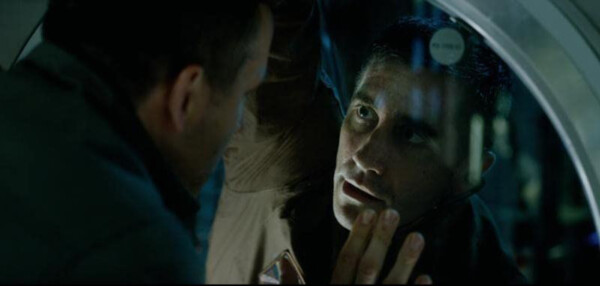
Image courtesy of Columbia Pictures.
“Life” Starring Jake Gyllenhaal, Rebecca Ferguson, and Ryan Reynolds. Directed by Daniel Espinosa. 104 Minutes. Rated R.
Del’s take
If you come away from “Life” with a strong sense of déjà vu, be not afraid. You’ve seen it before.
You saw it with “Alien.” You saw it with “Gravity.” You even saw it with “Invasion of the Body Snatchers.” “Life” is a 1950s-style science fiction B movie with 21st century special effects and a top-shelf budget and roster of actors. But despite the qualities and resources working in its favor, “Life” fails to generate much heat at the launch pad.
The story is standard-fare sci-fi/horror: A probe delivers soil samples from Mars to a crew aboard the International Space Station. An exobiologist discovers a protozoan-like organism in one of the samples and unwisely revives it. Then, as we have learned from countless sci-fi/horror films, the exobiologist unwisely feeds the organism and watches it grow until the day it abruptly decides glucose solution isn’t very appetizing and something heartier that will stick to its translucent ribs would be a better choice of menus.
There are no McRib sandwiches in outer space.

From there the movie becomes a grim struggle for survival as the astronauts match wits with the strangely resourceful and intelligent “Calvin,” as a schoolgirl has named it in a contest. To say anything about what happens next would spoil the movie for you, so I’ll fall back on my opening line. “You’ve seen it before.”
“Life” falls a smidge below the eye-catching and stomach-churning special effects of “Gravity,” but they’re still darned impressive, from soaring panaromas of the Earth and its landscape circling below to the weirdly unique environment of zero gravity inside the space station. (We even get a short tutorial on pooping in space. That toilet looked mighty small.)
Characters are thinly sketched as the monster mayhem ensues not long out of the gate. Jake Gyllenhaal is Dr. David Jordan, the station physician who seems slightly unhinged by his near record-setting time in space and does not want to return to Earth because a bad experience in Syria soured him on mankind. That moment of revelation is one of the few glimpses we receive of the man behind the doctor’s jumpsuit – and that’s more than what the other characters are given to bare except for station engineer Sho Murakami (Hiroyuki Sanada), who watches the birth of his child back on Earth via tablet.
Where the movie could have profited from its “Alien” DNA is in tension-building. Because the characters aren’t sufficiently developed and the action hurried onto the screen, it’s hard to care if they live or die. Director Espinosa should have followed Ridley Scott’s example and let us get to know these folks before exposing them to peril.
Some might interpret “Life” as a cautionary tale regarding the hubris of science, and they’d have plenty of ammunition. Again and again, science is portrayed as the rogue operator in this struggle of man vs. nature. But the movie never pursues that metaphor with any gusto. The missteps seem nothing more than means to achieve ends. Otherwise, there’d be no story.
“Life” deserves to be seen in a movie theater for its eye-popping special effects. The story itself is nothing special, and there are fewer thrills and chills than the trailers suggest.
Overall I would give it a grade of B-.
Del Stone Jr. is a former journalist and author.

Image courtesy of Warner Brothers.
“Kong Skull Island” Starring Tom Hiddleston, Samuel L. Jackson, Brie Larson. Directed by Jordan Vogt-Roberts. 1 hour, 58 minutes. Rated PG-13.
Del’s take
King Kong really needs to find a Mrs. Kong, if you know what I mean.
That poor, besotten beast, trapped all alone on Skull Island without the company of a female, has developed a frightening case of blue –
Cough cough cough. Ahem! Sorry about that. I momentarily forgot about this review’s PG rating.
Suffice it to say that in many of the Kong iterations we see a lonely ape the size of the federal deficit pining for a tiny but beautiful human woman, which ultimately leads to his demise, usually at the trigger finger of a sympathetic but competitive human male who has no intention of sharing his tiny but beautiful human woman with a giant ape, even if the giant ape is a movie star.
You don’t see that in many Plenty of Fish profiles.
In “Kong: Skull Island,” the eighth outing for the sexually frustrated mega-simian, movie fans receive a rehashing of many of the Kong tropes with a few new wrinkles that don’t add anything to the canon. But then the movie’s purpose is not to tread new ground but pave old ground for a sequel.
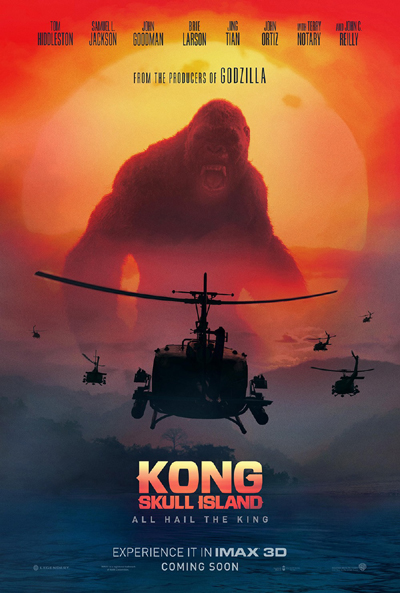
In “Skull Island” Bill Randa (John Goodman), a functionary in the Monarch organization (which figured into another recent giant creature movie), convinces a senator to fund a trip to Skull Island to look for, well, whatever is there – oil, uranium, or monsters.
Oh, and he needs a military escort.
That brings Lt. Col. Preston Packard (Samuel L. Jackson) into the picture, along with his unit of cannon fodder and one young non-com comedian (Thomas Mann). They’re joined by pacifist war photographer Mason Weaver (Brie Larson) and noted tracker Loki, er, James Conrad (Tom Hiddleston) to complete the lineup.
The group arrives aboard a fleet of helicopters that, after traversing some seriously bad weather that would have folks like you and me clutching air sickness bags like rosaries, reaches the jungle-infested canyons and scenic vistas of Skull Island. Hell immediately breaks lose and does not stop until about a hundred minutes later when the credits roll.
Pacing was off. My impression during the movie was that plot development was moving along too quickly, as if director Vogt-Roberts had taken input from an efficiency expert. Characters were hurriedly sketched, given only a short scene to establish their bonafides and histories, and then it was off to the races.
The script struck me as strangely flat. While the movie offered many funny lines, it missed what I thought were better opportunities for funnier lines. The actors had little to sink their teeth into.
John Goodman’s and Samuel L. Jackson’s characters were straight out of central casting, and as a result their particular branches of the conflict were similarly hackneyed. In fact the Jackson conceit, that of a military fanatic bent on destroying Kong, struck me as unrealistic and at times stupid.
Hiddleston and Larson were good despite the flat script, and Mann, as always, finds a way to inject life into his roles. John C. Reilly was excellent as World War II vet Hank Marlow, and his character provides the only watery-eye potential in the entire movie. Stay to the very end for that.
Many movies these days throw in an Easter egg after the credits, and you’ll need to sit through the entire run-through of credits for “Skull Island” to see which giant monster may figure into the sequel.
Overall I would grade “Skull Island” with a C+. I’ll give it high marks for a decent fight scene and monster mayhem, but low marks for clichéd characters, skimpy characterization, a threadbare script and hurried pacing.
Del Stone Jr. is a former journalist and author.
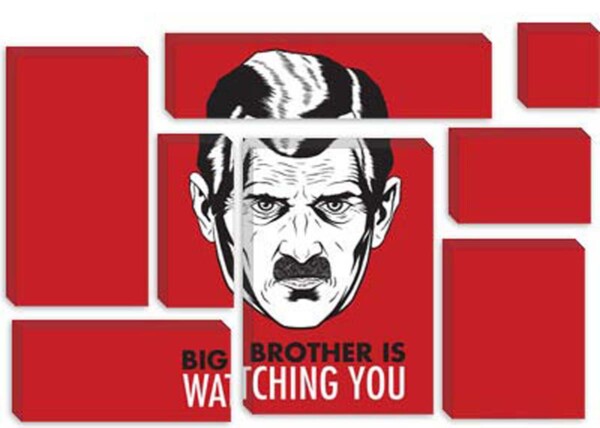
Image courtesy of a Creative Commons license.
I just had an interesting conversation with the manager of a local grocery outlet over the store’s policy that it scan my driver’s license for the purchase of beer.
The manager explained the store sold alcohol to a minor last year, and corporate instituted a policy whereby all alcohol purchases are verified by a license scan. If the store sells alcohol to a minor within a year of the last incident, it could “lose its license,” whatever that means.
She added that it hadn’t caused any problems except for one guy, an “87-year-old man” who became agitated and took his business elsewhere (the implication being that because he was old, he was a technophobe. Having had my personal information subjected to cyberattack three times in the past 10 years, I sympathize with his point of view).
I asked her what information is extracted from the scan. She said none, except the age. Then she said their systems can’t extract or store information, that they’re just screens. They even don’t have local access to information on the store discount cards.
That’s horseshit. They routinely run credit cards through those scanners. Information is extracted and sent to a server somewhere in the world, where the account’s credit is validated.
Then she said something that irritated me. She said – and I paraphrase here – that “they” (meaning the bad guys) are going to get your information anyway, so why worry about a grocery store scanning your license?
That’s an absurd line of reasoning. It’s like saying, “Oh well, I’ll probably die of cancer so I might as well start smoking.” I have no way of knowing, or stopping, a hacker from stealing my information – except to keep it as safe as possible. But I can say no to Giant Faceless Corporation when it asks for the keys to my digital kingdom.
I wonder which would be worse: a hacker stealing a few bucks from my checking account, or a faceless corporation using my personal information to influence my spending habits, buying choices, and other lifestyle issues? Or worse, selling that information to another corporation so that they could do the same.
Ultimately she sold me the beer without the scan because she had the power to override. But I couldn’t help but wonder about the absurdity of it all – me, an obviously legal-age individual having to quibble with a store manager over a license scan.
When people hear the expression “big brother” they think of government, but big brother can be any large, immovable entity that exerts control over you. More and more these days, corporations are looking like Big Brother.
About the author:
Del Stone Jr. is a professional fiction writer. He is known primarily for his work in the contemporary dark fiction field, but has also published science fiction and contemporary fantasy. Stone’s stories, poetry and scripts have appeared in publications such as Amazing Stories, Eldritch Tales, and Bantam-Spectra’s Full Spectrum. His short fiction has been published in The Year’s Best Horror Stories XXII; Alfred Hitchcock’s Mystery Magazine; the Pocket Books anthology More Phobias; the Barnes & Noble anthologies 100 Wicked Little Witch Stories, Horrors! 365 Scary Stories, and 100 Astounding Little Alien Stories; the HWA anthology Psychos; and other short fiction venues, like Blood Muse, Live Without a Net, Zombiesque and Sex Macabre. Stone’s comic book debut was in the Clive Barker series of books, Hellraiser, published by Marvel/Epic and reprinted in The Best of Hellraiser anthology. He has also published stories in Penthouse Comix, and worked with artist Dave Dorman on many projects, including the illustrated novella “Roadkill,” a short story for the Andrew Vachss anthology Underground from Dark Horse, an ashcan titled “December” for Hero Illustrated, and several of Dorman’s Wasted Lands novellas and comics, such as Rail from Image and “The Uninvited.” Stone’s novel, Dead Heat, won the 1996 International Horror Guild’s award for best first novel and was a runner-up for the Bram Stoker Award. Stone has also been a finalist for the IHG award for short fiction, the British Fantasy Award for best novella, and a semifinalist for the Nebula and Writers of the Future awards. His stories have appeared in anthologies that have won the Bram Stoker Award and the World Fantasy Award. Two of his works were optioned for film, the novella “Black Tide” and short story “Crisis Line.”
Stone recently retired after a 41-year career in journalism. He won numerous awards for his work, and in 1986 was named Florida’s best columnist in his circulation division by the Florida Society of Newspaper Editors. In 2001 he received an honorable mention from the National Lesbian and Gay Journalists Association for his essay “When Freedom of Speech Ends” and in 2003 he was voted Best of the Best in the category of columnists by Emerald Coast Magazine. He participated in book signings and awareness campaigns, and was a guest on local television and radio programs.
As an addendum, Stone is single, kills tomatoes and morning glories with ruthless efficiency, once tied the stem of a cocktail cherry in a knot with his tongue, and carries a permanent scar on his chest after having been shot with a paintball gun. He’s in his 60s as of this writing but doesn’t look a day over 94.
Contact Del at [email protected]. He is also on Facebook, twitter, Pinterest, tumblr, TikTok, Ello and Instagram. Visit his website at delstonejr.com .